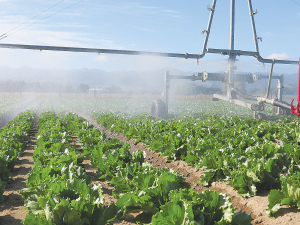Australian teams to help repair North Canterbury irrigators after storm
Moves are afoot to get a team of Australians over here to help repair North Canterbury's irrigation machinery, ravaged by the big windstorm of late October.
 Efficient use of water not only reduces energy use and saves production costs, but also contributes to yield and quality improvements.
Efficient use of water not only reduces energy use and saves production costs, but also contributes to yield and quality improvements.
Irrigation for horticulture has traditionally been used to supplement natural rainfall to ensure adequate growth and productivity from their crops.
Given water shortages, water use efficiency is a priority for the industry. Efficient use of water technologies not only reduces energy use and saves production costs but also matches the crop’s water requirement, contributing to yield and quality improvements.
Watermetrics stepped into cropping management in the 20/21 season by installing our equipment on kiwifruit in Gisborne, vineyards in Marlborough and potatoes in Mid Canterbury. By using our programmes, we made some encouraging progress in generating data to manage water and fertiliser applications.
Firstly, we installed 800mm soil probes. These read both temperature and moisture at 100mm intervals and report in 15-minute timespans. The presentation of the lines on the graph gives a clear picture of where a water application has got to in the soil profile and any overwatering becomes obvious. This is beneficial in calculating the irrigation amounts so that water gets to the effective root zone.
Secondly, we measured the water applications, recording the amount and timing of the applications.
Thirdly, we gathered comprehensive, paddockspecific climate information including rainfall collection. This equipment predicts the coming seven days weather including the important evapotranspiration.
While it is great to have all this data, one needs to put it all together so that effective management decisions can be made.
We used our partner Swan Systems to pull all this together and this model provided many management advantages.
Targets were set for nutrient levels at each growth stage and the programme could be used to record and modify applications as required. By connecting this with forecast weather and existing temperature, moisture and planned irrigation, we could define the appropriate time to make the correct applications.
We defined the soil and its drainage and water-holding capacity, as well as the crops desired moisture levels at each growth stage. Specific agronomic information such as midday stem water potential can be utilised in the settings.
This information was gathered from the grower, the agronomist and related to the comprehensive nutrient and water information resident in the Swan programme. Any required adjustments for the specific variety or site were included.</p.
The Swan Systems programme then sets a water budget depending on water volumes able to be used. It calculates the amounts of water required to meet the set targets and includes in this the predicted evapotranspiration and rainfall. It details the day and amounts to be applied, information that transfers to cell phones.
A desired target was set for the root zone for moisture and allowed for an operating zone. The application issues warnings if you approach those limits outside the zone.
Managers found it easy to stay within those limits and basically were able to keep the moisture close to requirement. This takes moisture stress out of the equation, limits disease problems, and increases the crop’s ability to reach its potential, which is far less likely if fluctuations were allowed to occur. From the factual information gathered, you can see the effects of inadequate irrigation and the difficulty of getting it back to where it should be. The information generally meant earlier applications with less water than would have been normally applied.
Comprehensive daily data history can be printed out in PDF form. Analysis of this pinpoints mistakes and better ways of doing things for a future crop.
We believe this application helps address many of the environmental/ water problem areas in crop growing and contributes to water and cost savings as well as catering for optimal crop requirements.
Richard Campion is an agronomist at Watermetrics. Email This email address is being protected from spambots. You need JavaScript enabled to view it.
Fears of a serious early drought in Hawke’s Bay have been allayed – for the moment at least.
There was much theatre in the Beehive before the Government's new Resource Management Act (RMA) reform bills were introduced into Parliament last week.
The government has unveiled yet another move which it claims will unlock the potential of the country’s cities and region.
The government is hailing the news that food and fibre exports are predicted to reach a record $62 billion in the next year.
The final Global Dairy Trade (GDT) auction has delivered bad news for dairy farmers.
One person intimately involved in the new legislation to replace the Resource Management Act (RMA) is the outgoing chief executive of the Ministry for the Environment, James Palmer, who's also worked in local government.

OPINION: The release of the Natural Environment Bill and Planning Bill to replace the Resource Management Act is a red-letter day…
OPINION: Federated Farmers has launched a new campaign, swapping ‘The Twelve Days of Christmas’ for ‘The Twelve Pests of Christmas’ to…